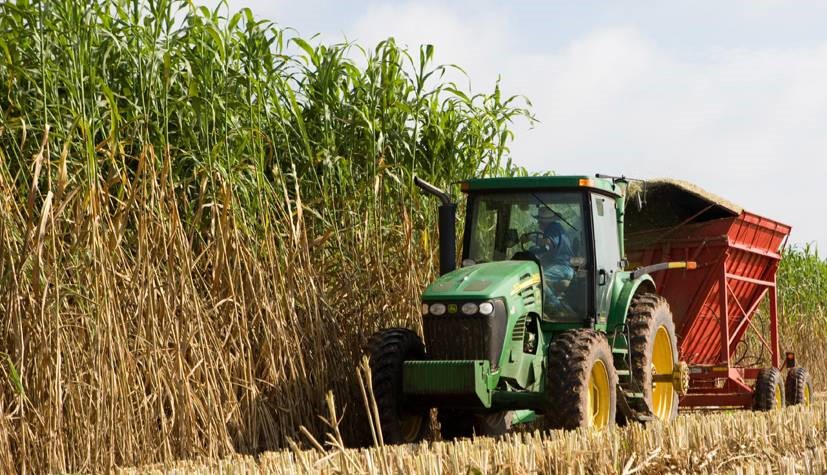Bioenergy sorghum’s roots can replenish carbon in soil
Texas A&M AgriLife study shows the annual crop can sequester atmospheric carbon dioxide
The world faces an increasing amount of carbon dioxide in the atmosphere and a shortage of carbon in the soil. However, bioenergy sorghum can provide meaningful relief from both problems, according to a new study by Texas A&M AgriLife Research scientists.

The study, “Bioenergy sorghum’s deep roots: A key to sustainable biomass production on annual cropland,” was recently published in GCB Bioenergy.
According to the research, bioenergy sorghum hybrids capture and sequester significant amounts of atmospheric carbon dioxide in soil. The crop can improve soil fertility and potentially earn carbon credits to offset greenhouse gas emissions.
In addition, the study shows that bioenergy sorghum’s unusually deep root system can reach sources of water and nutrients untapped by other annual crops. These results suggest the crop can help manage fertilizer runoff from other annuals in a crop rotation.
The senior investigator for the work is John Mullet, Ph.D., professor and Perry L. Adkisson Chair in Agricultural Biology in the Department of Biochemistry and Biophysics. A key collaborator is Bill Rooney, Ph.D., professor and Borlaug-Monsanto Chair for Plant Breeding and International Crop Improvement, Department of Soil and Crop Sciences. Both are in the Texas A&M College of Agriculture and Life Sciences, Bryan-College Station.
The U.S. Department of Energy Great Lakes Bioenergy Research Center and the Advanced Research Projects Agency-Energy funded the project.
Texas A&M-bred annual bioenergy crop

Mullet is an expert in bioenergy crops’ genomics, genetics and gene regulatory networks. Rooney spearheaded the development of bioenergy sorghum hybrids over the past 20 years. For the past 15 years, Rooney and Mullet have collaborated to develop bioenergy sorghum.
In fact, Mullet and Rooney have been working to improve bioenergy sorghum varieties to produce an ideal annual bioenergy crop. The hybrid used in the recent study creates high yields of biomass for fuel, power and bioproduct generation. The crop also has excellent drought resilience, good nitrogen-use efficiency and a deep root system.
“There is an assumption that the most sustainable bioenergy crops are perennial because they require fewer inputs and can sequester more biomass than annuals,” Rooney said. “Those statements are true, but U.S. agriculture always requires annual cropping varieties and options as well.”
New benchmark for carbon credit modeling, soil fertility
The study shows that an acre planted with a bioenergy sorghum hybrid accumulates about 3.1 tons of dry root biomass over the crop’s 155-day growing season. Bioenergy sorghum roots also grew to over 6.5 feet deep over their growing season.
These new metrics make it easier to predict how much atmospheric carbon dioxide might be captured inside roots. The numbers can also shed light on how many carbon credits a planted field might earn.
“Frankly, the numbers are quite favorable,” Rooney said.
The numbers are also important for understanding the crop’s potential to improve soil fertility and water-holding capacity by replenishing soil organic carbon. However, previous research has shown that in the U.S., soil organic carbon levels have fallen by 50% over the past 100 years in land planted with annual crops.
This drop in soil carbon levels could be due to cropping practices, microbial activity and changing land use, Rooney said. These complex factors mean that predicting how long it might take to replenish lost carbon requires sophisticated modeling. The restoration process is likely to take many decades.
“For modeling, they need to have a realistic number to start with,” Rooney said. “We haven’t historically had enough info to do that, but this study provides a benchmark for scientists and policymakers.”
A need for further research
In this study, Rooney and his team managed the field trials and helped with phenotyping. Mullet and his team characterized the root system and the genes expressed within.
Over multiple years, the study considered in-depth how one bioenergy sorghum hybrid interacts with two soil types, Rooney said. He stresses the need to conduct further research.
“In this study, we didn’t sample the genetic diversity of bioenergy sorghum at all, except for one standard type,” Rooney said. “And looking at multiple environments and expanding the range of we are evaluating is essential.”
Bioenergy sorghum as part of a sustainable bioenergy production system
Modeling studies estimate that millions of acres of abandoned and marginal cropland in the U.S. are available for planting. Many of those acres are in the Gulf Coast region. The region is ideal for bioenergy sorghum production because of ample rainfall, long growing seasons and low competition with grain crops, Mullet said. Furthermore, the crop has improved over the years in terms of productivity, resilience and composition, thanks to Mullet’s and Rooney’s efforts.
“Recently, I’ve decided the most important thing we can do is continue research on bioenergy sorghum optimization, but also to help design and build biorefineries that will process materials from the crop in a way that’s optimal,” Mullet said.
Carbon captured in biofuels and bioproducts at biorefineries, and by bioenergy sorghum roots could generate carbon credits, potentially benefiting producers and industry.
Yet despite the Gulf Coast’s excellent potential for biofuels production, there are no bioenergy research centers and very few biorefineries in the region, Mullet said.
Therefore, Mullet is now working to attract industry and government funding to help build the next generation of biorefineries designed to use bioenergy sorghum biomass for the production of biofuels, bioproducts and biopower.
“The project has expanded to not just producing biofuels and bioproducts, but also directly capturing carbon and sequestering it,” he said.
-30-
Olga Kuchment | 510.847.7204 | [email protected]
Olga Kuchment is a communication specialist for Texas A&M AgriLife Communications in College Station. She is responsible for writing news releases and feature articles from science-based information generated or provided by AgriLife faculty throughout the state.